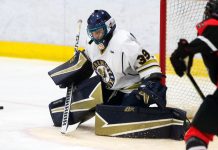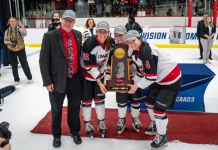Odd Man Out
This past weekend concluded the annual NCHA-MIAC interlocking schedule, which provides the bulk of non-conference games for teams in those leagues. Over a three week span, the conferences played a total of 51 games against each other, with the NCHA coming out on top 30-14-7.
Although it is occasionally tinkered with, the scheduling agreement between the two leagues has been in place for several years, and is planned to continue indefinitely.
“There’s something like a 40 year schedule,” said Wisconsin-Stout coach Terry Watkins. “Teams rotate opponents and home ice.”
The problem is that there are eight NCHA teams and nine MIAC teams, and the scheduling system in place cannot account for that. So, on a rotating basis, each MIAC team is left out of the arrangement for a duration of two years. St. John’s was the odd team out last season and is again this season.
The timing for this is never good, but it’s even harder when you’re trying to put together a schedule with a high enough degree of difficulty to make your team a contender for an at-large NCAA bid, should you not win your conference. This is especially true since last season when the all NCAA Division III sports went to a system where you are assigned points based on the winning percentages of the teams you play.
When I talked to St. John’s coach John Harrington about this last season, he said, “I think it hurts our credibility, not banging heads with a pretty strong league.”
St. John’s was able to play only one NCHA team last season, instead filling its non-conference portion of the schedule with teams from the MCHA, which typically have lower winning percentages, and a trip east to play in the Times-Argus Tournament at Norwich. Unfortunately, the NCAA does not consider out-of-region games when evaluating teams for at-large bids, so those games didn’t count.
Things are a bit better for the Johnnies this season, with three games against NCHA opponents that fall outside of the scheduling agreement, including weeknight games against Wisconsin-Stout and Wisconsin-Superior and a Saturday night tilt against Wisconsin-Stevens Point.
Next year, on the other hand, may be a real problem, according to Watkins. “Concordia is the team left out next time,” he said. “And they’re in the middle of nowhere compared to the rest of us.” Concordia is in Moorhead, Minn., just over the board from Fargo, North Dakota. It’s several hundred miles away from the Twin Cities area, where the rest of the MIAC is based. So far, in fact, that instead of playing weekend home-and-away series like the rest of the MIAC does, Concordia plays both weekend games with each school either home or on the road, alternating sites each season.
Getting games that fall outside the NCHA-MIAC scheduling agreement usually means playing the MCHA, but all of those teams with the exception of Minnesota-Crookston are based in Wisconsin and Michigan. Non-conference games will be hard to do for Concordia, especially enticing teams to come to Moorhead.
“It’s been a nightmare so far,” said Concordia coach Steve Baumgartner. “We’re having a lot of trouble picking up those six games (each year).”
Baumgartner is looking into everything from tournaments out East to a trip to Europe. ‘We’d like to see them bring back our (MIAC) Thanksgiving Tournament, because that would give us three games,” he said. “But that would put some of the other schools over the limit. And if you get rid of the NCHA scheduling agreement altogether, then that would be a nightmare, too.”
“We realize that this is an issue and it’s going to be addressed at our scheduling meeting on December 13,” said Watkins.
“We’re hoping for some relief at the meeting on the 13th, but I’m not sure what’s going to happen,” said Baumgartner. “I’ve been working on the schedule for over a year, and there are still a lot of holes. I’m hoping to get some road games set up for next season, but then there’s the matter of getting those teams to play us at home the next year, because of our location.”
Another change to expect is some juggling of the dates for the NCHA-MIAC games. “For the past two seasons we’ve played all of these games first, before starting conference play,” said Watkins. “Next season it looks like we’ll split it up and play two weekends of inter-conference games, then play some league games, then come back and play another weekend with the MIAC.”
Quote of the Week: “When you win, you always love (the shootout). It was fun, the fans like it. You hear about how it goes against the integrity of the game, but I’ve seen games decided in overtime by goals that bounce off guy’s heads, really weird goals.” — Norwich coach Mike McShane on his team’s shootout victory over Middlebury in the Primelink Great Northern Shootout
When Is A Tournament Not a Tournament?
The schedule will tell you that there were seven tournaments held Thanksgiving weekend. But there were actually just four. The others called themselves tournaments, but they were not .. at least by this reporter’s standards.
I’m old school, so pardon me for considering a tournament to mean:
•There is a single location
•There are at least four teams
•There is a championship game
Based on those criteria, the following were real tournaments: The Primelink Great Northern Shootout (Norwich, Middlebury, Potsdam, Plattsburgh), the Babson Tournament (Gustavus Adolphus, Babson, Brockport, Skidmore), the PAL Cup (St. Anselm, Plymouth State, S. New Hampshire, Assumption) and the Charles Luce Tournament (Trinity, Conn College, Amherst, Wesleyan). I listed the teams in order of finish, which you can do in a real tournament.
On the other hand, the following were not real tournaments:
•St. Norbert Tournament — Only three teams (St. Norbert, Marian, Lake Forest), and just one game a day. I guess St. Norbert won, because it went 1-0-1, while Lake Forest was 1-1 and Marian was 0-1-1.
•Wisconsin-Stout Tournament — This had a pre-determined schedule with St. John’s and Wisconsin-Stout both playing Marian and Lawrence. Both Stout and St. John’s went 2-0, so I’m not sure who, if anybody, won. At least St. John’s and Stout played each other the Tuesday prior to the tournament.
•Bowdoin/Colby Faceoff Classic — Four teams, but a pre-determined schedule played on both campuses. I guess we’ll call the US Under 18 team the winner here, since it swept Bowdoin and Colby by a combined score of 10-2, while both the hosts school defeated Salve Regina by a combined score of 19-4.
Here’s another example of why these are not real tournaments — Oswego and RIT traveled to New England College and Williams that same weekend, playing the host schools on successive nights. All the teams had to do was pitch in $40 for a trophy, and they could have called that a tournament, since it used the same format as Bowdoin/Colby.
Please, please stop the insanity. When I talk to coaches about this, some like the pre-determined format since it means they get to play schools they don’t normally see. Just don’t call it a tournament then (although in fairness, the games at Bowdoin/Colby were called the “Face-Off Classic”). Plus, you can schedule your semifinals that way and leave the option open for a great championship game between rivals.
In the best tournament in Division III, the Primelink, you have the same four teams every year, but it’s the rivalries, combined with the added excitement of a championship game, that makes it special. Nobody, fans, players, or coaches says, “Ah, shucks, another Norwich-Middlebury game”.


